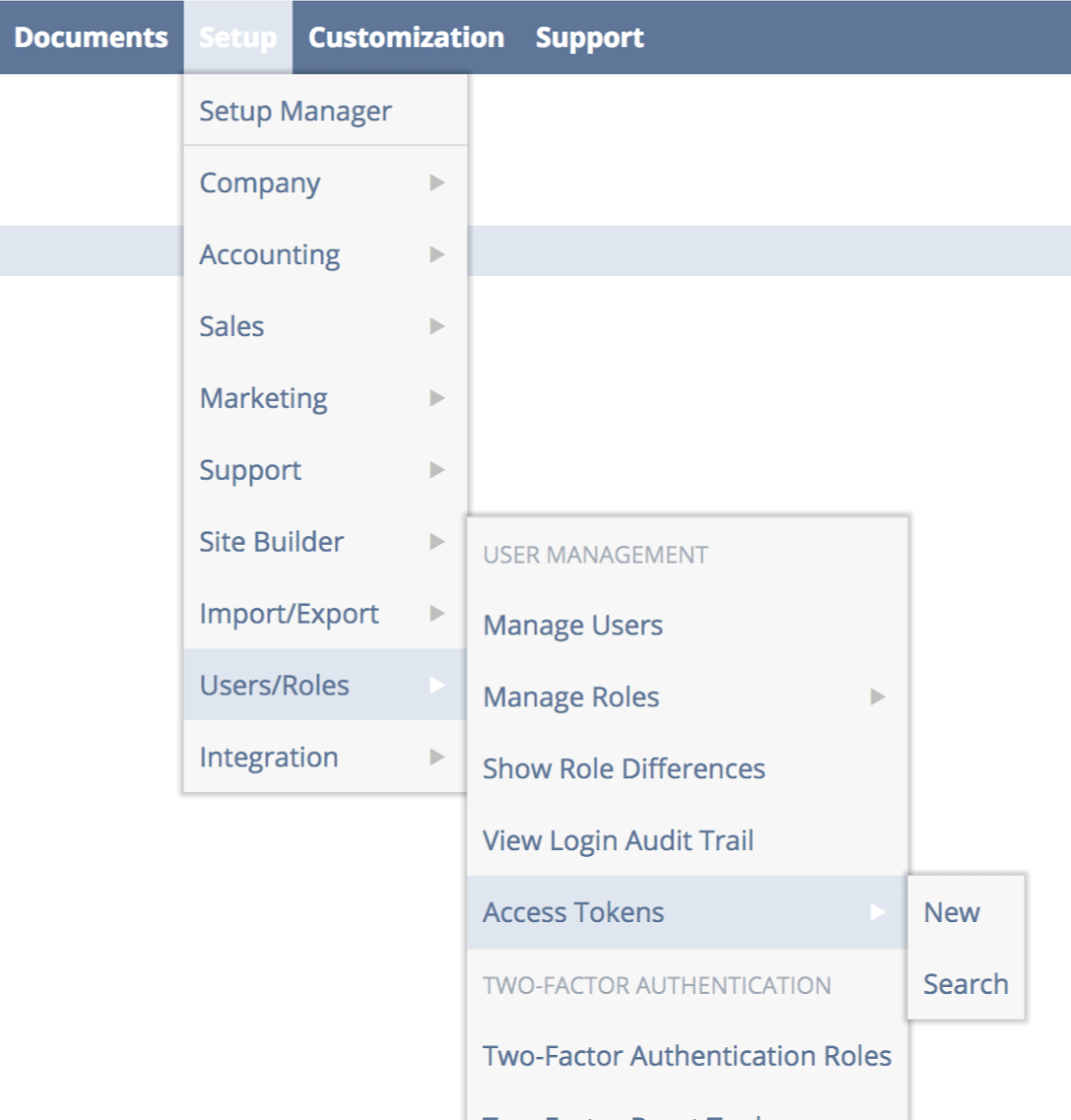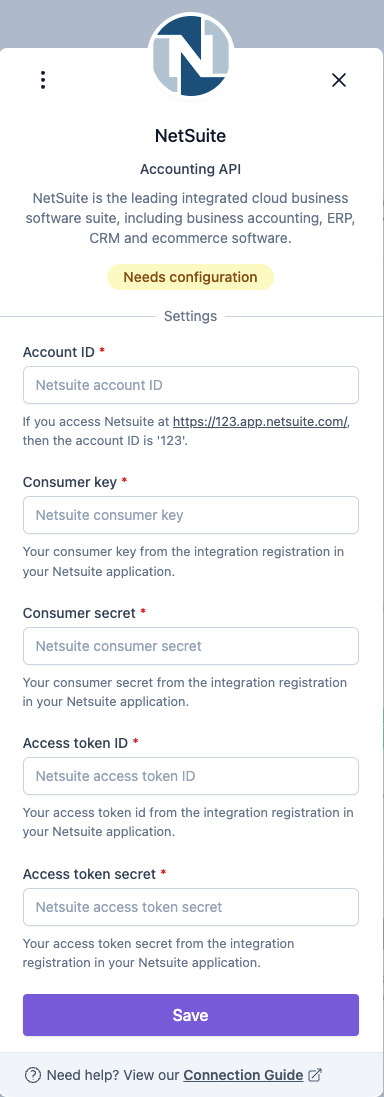Connect to NetSuite
This guide will walk you through the process of setting up NetSuite User Roles to get Access Tokens using Token-Based Authentication. Access tokens are used to authenticate requests to NetSuite APIs, which enables you to integrate NetSuite with other applications.
By following these steps, you can grant specific NetSuite User Roles access to generate Access Tokens and use them to access NetSuite APIs securely.
Steps:
Info: This guide assumes you have a basic understanding of NetSuite and its interface.
Create a new User role
To grant access to the Netsuite, you need to create a user role to get Access Tokens using Token-Based Authentication
-
User Roles to get Access Tokens using Token-Based Authentication:
-
Log in to your NetSuite account as an administrator.
-
Go to Setup > Users/Roles > Manage Roles.

-
Click on the 'New' button to create a new role.
 Give the role a name (e.g. Integration Role).
Give the role a name (e.g. Integration Role). -
Under the 'Permissions' tab, select the appropriate permissions that you want to grant to this role.
 Note that the role must have the necessary permissions to perform the tasks that the integration will be used for.
Note that the role must have the necessary permissions to perform the tasks that the integration will be used for.We recommend to review the permission levels for the various sections:
For "Transactions","Lists" we recommend to set the permission to "View" to allow reading data and "Full" to allow creating and/or modifying data. For "Lists","Currencies" we recommend to set the permission to "View" to allow reading data and "Full" to allow creating and/or modifying data. For "Setup", the only option is "None" or "Full", please set it to "Full" to grant access to the Netsuite instance.
For more details about the Netsuite permission levels, please refer to the Access Levels page in NetSuite Help Center.
Important for Projects Functionality: To enable customer-to-project mapping and full project management features, ensure the following permissions are granted:
- Lists > Projects: Required for accessing job/project records
- Transactions > Time Entry/Time Tracking: Needed for project time management
- Lists > Customers: Required for customer-project relationship mapping
Transactions
TRANSACTIONS PERMISSION LEVEL Access Payment Audit Log View/Full Audit Trail View/Full Automated Cash Application View/Full Bill Purchase Orders View/Full Bills View/Full Calculate Time View/Full Cash Sale View/Full Cash Sale Refund View/Full Check View/Full Credit Card View/Full Credit Card Refund View/Full Credit Memo View/Full Credit Returns View/Full Customer Deposit View/Full Customer Payment View/Full Customer Refund View/Full Deposit View/Full Deposit Application View/Full Edit Forecast View/Full Enter Opening Balances View/Full Enter Vendor Credits View/Full Estimate View/Full Expense Report View/Full Finance Charge View/Full Find Transaction View/Full Fulfill Orders View/Full Generate Price Lists View/Full Generate Statements View/Full Import Online Banking File View/Full Invoice View/Full Invoice Approval View/Full Invoice Sales Orders View/Full Item Fulfillment View/Full Item Receipt View/Full Make Journal Entry View/Full Matching Rules for Online Banking View/Full Opportunity View/Full Pay Bills View/Full Payments View/Full Pay Sales Tax View/Full Post Vendor Bill Variances View/Full Posting Period on Transactions View/Full Purchase Order View/Full Receive Order View/Full Receive Returns View/Full Reconcile Edit Refund Returns View/Full Return Auth. Approval View/Full Return Authorization View/Full Sales Order View/Full Sales Order Approval View/Full Set Up Budgets View/Full Statement Charge View/Full System Journal View/Full Timer View/Full Time Entry View/Full Time Tracking View/Full Track Time View/Full Transfer Funds View/Full Vendor Bill Approval View/Full Vendor Payment Approval View/Full Vendor Return Auth. Approval View/Full Vendor Return Authorization View/Full Vendor Returns View/Full View Gateway Asynchronous Notifications View/Full View Payment Events View/Full Reports
REPORTS PERMISSIONS LEVEL SuiteAnalytics Workbook Edit List
LISTS PERMISSIONS LEVEL Accounts View/Full Classes View/Full Companies View/Full Contacts View/Full Currency View/Full Customers View/Full Documents and Files View/Full Departments View/Full Items View/Full Locations View/Full Projects View/Full Subsidiaries View/Full Tax Records View/Full Vendors View/Full Setup
SETUP PERMISSIONS LEVEL Accounting Lists Full Accounting Management Full Deleted Records Full Log in using Access Tokens Full Other Lists Full REST Web Services Full SOAP Web Services Full
Assign a user to the role
It is recommended that you create a separate user for this purpose instead of assigning the role to an existing user. It helps with better tracking and auditing operations.
-
Click Lists > Employees > New
-
Enter the employee details (e.g. Integration User), and email address.

-
Click Access tab

-
select Give Access.
-
Enable Manually Assign or Change Password and specify a password.
-
-
Under Roles, select the role that you created in Step "Create a new User role" from the drop down list (e.g. Integration Role) and click Add.

Create an Application
Once the role is set up, you can follow these steps to generate the consumer Key & Secret:
-
Log in to your NetSuite account with a user who has been assigned the role (e.g Integration Role) that has access.
-
Go to Setup > Integrations > Manage integrations.

-
Click the 'New' button to create a new integration or select an existing integration that you want to use.

- Name: Enter a meaningful name (for example, Integration App)
- Authentication: Under the 'Authentication' section,
- select 'Token-Based Authentication.'
- For TBA: Authorization flow set
https://unify.apideck.com/vault/callbackas callback URL.
- Oauth 2.0: Under the 'Oauth 2.0**' section,
- Check "Authorization Code grant"
- Check "REST API services"
- Set
https://unify.apideck.com/vault/callbackas the redirect URI.
Click the 'Save' button to save the changes.
-
Once saved, the Consumer Key and Consumer Secret will be generated.
💡 REMARK: Copy the "Consumer Key" and the "Consumer secret". You can not access this information once you exit this screen.

Create Access tokens
Create a New Access Token with the Role just created.
- Go to Setup > Users/Roles > Access Tokens.

-
Click the 'New' button to create a new Access token
-
Complete the form

-
Select the "Application name" that you have created in the previous step (e.g. Integration App).
-
Select the "User", which we created in the previous steps (e.g. Integration User)
-
Give the token a recognizable "token name", for example Integration Token
-
Click the 'Save' button to save the changes.
-
4- Once saved, the Account Token ID and Secret will be generated.
💡 REMARK: Copy the "Token Id" and the "Token secret". You can not access this information once you exit this screen.
Find your Account ID
-
Go to Setup > Company > Company Information
-
Copy the Account ID

Configure the Netsuite connection
Enter the Account ID, Consumer Key, Consumer Secret, Token ID and Token Secret to get started with the integration.
